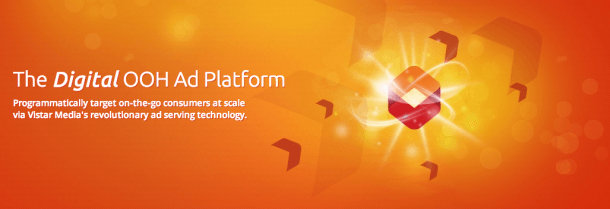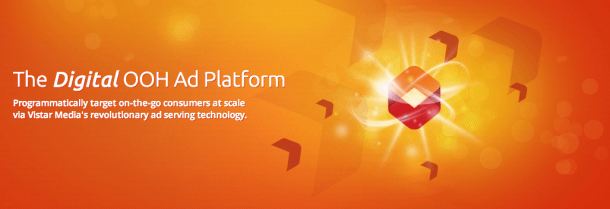
Q&A: Vistar Media Bringing Automated Buying To Digital OOH
May 14, 2013 by Dave Haynes
The deal announced a few weeks ago that saw Vistar Media raise $1.5 million to help fund the first real automated buy and sell platform for Digital OOH reminded me I wanted to do a broader piece on the company.
Vistar co-founder Jeremy Ozen and I have been going back and forth on an email interview that explains what the company is about and how it differs from earlier failed or struggling efforts to make buying and selling the medium a one by one by one thing.
Q – Let’s start with an overview of Vistar. How was the company founded and why? Who runs things? Where are you based? That sort of stuff.
 Michael Provenzano, Jeremy Ozen and Mark Chadwick founded Vistar Media in September 2011. Michael and Mark previously had worked together at Invite Media, where Michael was a co-founder and Mark was the Chief Architect. The founding team started Vistar Media in order to bring programmatic technology – and ultimately more demand – to the Digital Out of Home media segment. Vistar Media’s engineering team is based in Philadelphia and our business/sales team is based in NYC.
Michael Provenzano, Jeremy Ozen and Mark Chadwick founded Vistar Media in September 2011. Michael and Mark previously had worked together at Invite Media, where Michael was a co-founder and Mark was the Chief Architect. The founding team started Vistar Media in order to bring programmatic technology – and ultimately more demand – to the Digital Out of Home media segment. Vistar Media’s engineering team is based in Philadelphia and our business/sales team is based in NYC.
Q – There are a pile of phrases and acronyms associated with ad buying exchanges. Are you an RTB, DSP or a new one I need to learn?
A little history here. Brian O’Kelley, one of the architects of the platform that became Right Media (which was ultimately purchased by Yahoo in 2007) started AppNexus soon afterward. AppNexus provided the first exchange to facilitate real time purchasing of display ads at scale. The value of RTB was that buyers could bid on specific impressions as they became available. Demand Side Platforms, one of which was Invite Media, arose to enable agencies to bid on this inventory in real time. Think of Demand Side Platforms as Scottrade or E-trade – platforms that enable simplified buying. Think of exchanges as NASDAQ – the markets where the transactions actually occur.
Programmatic buying has grown to bring similar methods of buying to other digital media formats. Radio has started to implement some forms of programmatic, TV to a limited extent, and Digital Out of Home. RTB – Real Time Bidding – is a subset of programmatic, in which bids are made many times within microseconds on particular impressions.
Q – As a media owner, how do I plug in?
Media Owners integrate – or plug in with our system – via their content management systems (CMS). Vistar Media integrates with the CMS of every media owner (Park Media, Coolsign, Dynasign etc.) we do business with. In some instances media owners have a proprietary CMS. Our integration will enable their CMS to request individual spots from Vistar as they present themselves. If there are valid campaigns live in the exchange, Vistar will respond to the CMS with an ad to play and a tracking URL, which enables both media owners and buyers to track the campaign’s specific spending. Except for allocating inventory in the CMS to the request from Vistar, the entire process is hands off and automated.
Q – As a media planner, how do I use it?
This depends on the type of media planner you are. TV-oriented buyers normally would let our team set up and execute campaigns on their behalf. Agency trading desks (e.g. Cadreon, Xaxis, Vivaki) would use the dashboard as a self service client. The way it is used depends on the goals of the client.
Q – You have done a deal that integrates with SpaFax and, by extension, WPP. Does that limit your ability to work with the other big media holding companies?
Integration is not an accurate description. Spafax has licensed third party data to inform the way they buy DOOH. Their methodology requires programmatic technology to execute at scale.
We work with agencies and different trading desks under all of the holding companies. Spafax is just one of our clients. Our other clients have their own methodology of applying data to target audiences across DOOH. At Invite Media our first big client was Vivaki, but Invite is used across agency holding companies. It’s no different here.
Q – Do you see Vistar as a separate destination portal or underlying, enabling tech for agency systems?
We provide a business-to-business interface for buyers of digital out of home media, as well as the enabling technology for those media owners to sell a lot more of their inventory.
Q – What’s the primary attraction of this model?
Programmatic technology enables buying at scale, transparency, accountability, and the application of data for targeting and reporting. The sum of these benefits is the ability to prove effectiveness and ROI of the medium which has been lacking to date.
Q – What are the primary objections? I assume price erosion and commoditization of media is a concern.
Generally speaking our media partners are optimistic about the value programmatic technology can bring to the DOOH media segment overall. Opening up inventory leads to concerns around channel conflict, but this is something we work very closely with our partners to manage. I think most industry observers would agree that it has worked very well in online display environments for both buyers and sellers.
This is a very important point for us. Relationships with our media partners are the heart of our business. We pick the term “Partners” with a purpose — we are working together to educate the market and progress the industry as a whole.
Q – Do media operators see this as a way to unload remnant time or the primary way to sell going forward?
While our media partners request ads only for the unsold portion of their inventory, we do not see this as a remnant monetization tool. We are collectively trying to expand the opportunity set of buyers that can buy DOOH. As an example, we have run campaigns for mobile ad networks who use DOOH as an extension to the geo-targeting they are doing on mobile. Mobile buyers are not all of a sudden interested in DOOH because of price — it is the ability to seamlessly extend their existing buy that has enabled this opportunity.
The traditional sales effort by our media partners’ direct sales teams will 100% continue in the way it has historically. Our platform is just viewed as the gateway to budgets that previously ignored DOOH — be that broadcast, online video/digital branding, or mobile. If we succeed in our mission, then the opportunity set of sales channels for our media partners will have expanded tremendously.
Q – How does this differ from some earlier attempts at aggregating and selling Digital OOH media, like rVue and SeeSaw and Adcentricity?
There are two, very important, differences:
1) Technology — Vistar Media has spent years building ad serving technology customized to the nuances of DOOH. Building these pipes and working hand in hand with media owners was a massive investment of time, energy, and money. Our partnerships with trading desks/mobile ad networks/online video marketplaces and the subsequent demand we are working to generate from these sources are impossible to access without technology such as ours.
2) Data/ROI — DOOH suffers from a supply/demand imbalance because it can’t answer two simple questions: how do I know this media works? And, how do I judge its effectiveness? So, simply aggregating DOOH through a single portal and making it easy to buy doesn’t solve the problem. In other words, if I wasn’t interested when it was hard to buy because I can’t judge the ROI, making it easier to buy doesn’t change the story. rVue, SeeSaw, and Adcentricity were all focused on aggregation. We are going well beyond that.
Our focus is on increasing underlying demand for the media by showing it works. “Works” is a relative term so that conversation depends on the type of buyer/client. However, the underlying programmatic platform is the stepping stone to solving the core issue. It is the first of its kind, and provides major differentiation.
Q – How do you deal with all the formats and lack (still) of standards?
We use a transcoding technology that allows us to ingest a single video file and transcode it to the specifications of each media partner. Previously, ad trafficking across DOOH was indeed painfully tedious. But we’ve solved for that through the integrations and encoding process. Ironing out these issues is what enables us to focus on the substantial issues.




Leave a comment